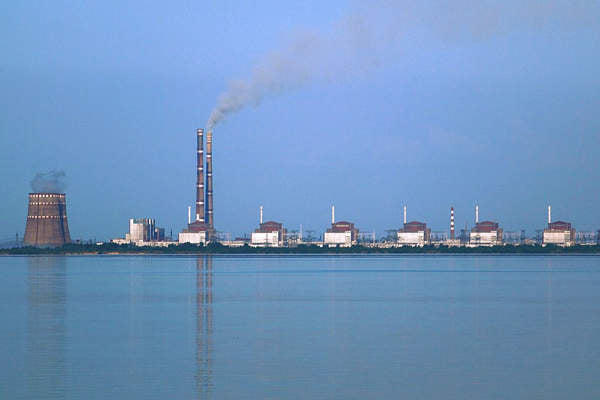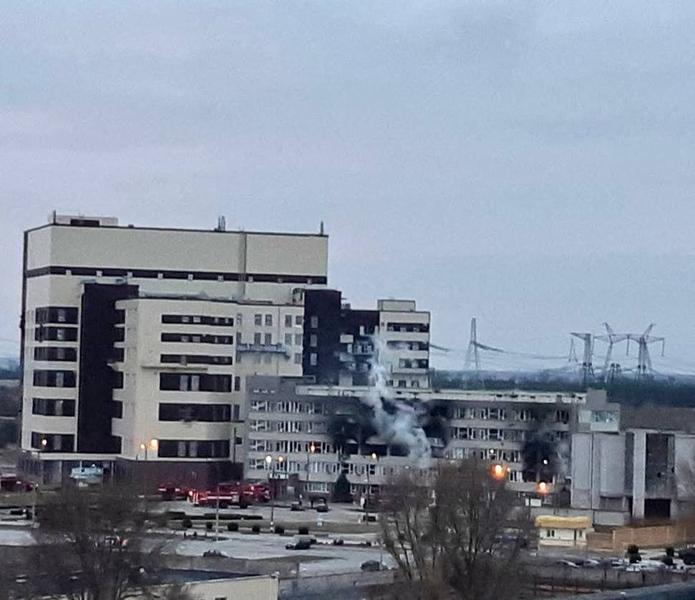
According to a Reuters analysis, the Zaporizhia nuclear power plant in southern Ukraine has been bombed in recent days, opening up the possibility of a major accident just 500 kilometers from the site of the world’s worst nuclear accident, the 1986 Chernobyl disaster.
UN Secretary-General Antonio Guterres on Thursday called on Russia and Ukraine to stop all fighting near the plant after new shelling.
What is the structure of the plant?
The Zaporizhzhia nuclear power plant is the largest in Europe and one of the largest in the world. Its construction began in 1980, and the sixth reactor was connected to the network in 1995.
The Zaporizhzhia NPP has six Soviet-designed VVER-1000 V-320 water reactors containing uranium-235, which has a half-life of more than 700 million years.
As of July 22, only two of its reactors were operating, according to the Nuclear Energy Agency (NEA).
Which is the biggest risk for reactors
The biggest risk for reactors is a drop in water supplies.
Pressurized water is used to transfer heat from the reactor and to slow down the neutrons.
A neutron moderator is needed to slow down fission neutrons (thermal neutrons) to increase their efficiency in creating new fission reactions. The moderator must be a light element that allows neutrons to collide without being captured. Ordinary water, heavy water or graphite is used as a retarder.
If the water is shut off and auxiliary systems such as diesel generators cannot keep the reactor cool due to an attack, the nuclear reaction will slow down and the reactor will heat up very quickly.

Zaporizhzhia NPP Photo: Energoatom
Limited risk
At such high temperatures, hydrogen can be released from the zirconium shell and the reactor can begin to melt.
However, experts say the building that houses the reactors is designed to contain radiation and withstand strong shocks, meaning the risk of a major leak there is still limited.
“I don’t think there would be a high chance that the containment building would be breached even if it were accidentally hit by an explosive projectile, and even less likely that the reactor itself would be affected by one. This means that the radioactive material is well protected,” said Mark Wenman, nuclear materials specialist at Nuclear Energy Futures, Imperial College London.
What happens to spent fuel?
In addition to the reactors, there is also a spent nuclear fuel repository, as well as spent fuel pools at each reactor that are used to cool it.
After service in a nuclear power plant reactor, “spent nuclear fuel” remains radioactive and emits heat. It is then removed from the reactor and temporarily stored in a storage pool before being sent for reprocessing and final storage.
Residual heat released by the heat-releasing elements after the reactor shutdown must be removed, which means that the spent nuclear fuel storage pool must be continuously cooled.

Spent nuclear fuel cooling pool (Photo: Simone Ramella / Wikipedia)
“If you don’t add fresh water, the water will evaporate. Once the water evaporates, the zirconium coating will heat up and can catch fire, and then we’ll have a bad situation – an irradiated uranium fire that’s very similar to the Chernobyl situation, releasing a whole range of radioactive isotopes,” said Kate Brown, an environmental historian with of the Massachusetts Institute of Technology, whose book “The Survival Guide” documents the full scale of the Chernobyl disaster.
A hydrogen leak from a spent fuel pool caused an explosion at Fukushima’s fourth reactor in 2011.
According to a document submitted by Ukraine to the IAEA in 2017, there were 3,354 spent heat-releasing assemblies in dry storage and approximately 1,984 spent heat-releasing assemblies in pools.
That totals more than 2,200 tons of nuclear material, excluding reactors, according to the document.
1,200 tons of nuclear fuel are stored at Europe’s largest nuclear power plant in Zaporizhzhia, which the Russian invaders are now threatening to blow up. If Russia decides to carry out a terrorist attack, the nuclear catastrophe will affect both the territory of Russia and Ukraine,” warned Oleksandr Starukh, head of the Ukrainian Regional Military Administration in Zaporizhzhia, on his Telegram account.
Could the plant explode – and if so – what would happen?
According to experts, it is possible, but the probability of this is small.
“What we have here, involving the military, is very complex… If several critical factors come together, an explosion is possible,” Ross Peel, head of the Center for Research and Knowledge Transfer, told Al Jazeera. Science and Security Research at King’s College London.
“It’s hard to say whether it is [se va întâmpla] and possible consequences thereof. It depends on how the explosion will happen,” he added.
Immediately after the explosion, experts say that an invisible radioactive cloud could lead to a large-scale evacuation. However, the effects of the radiation leak will likely be felt for years.
“You will probably see hundreds of thousands of people trying to flee the area,” Ramana told Al Jazeera.
“There will be a cloud, but you will not see it… We can watch the cloud because [avem] sensitive devices that measure the level of radiation,” he added.
Some of the illnesses we might see after such an explosion could be acute radiation poisoning or cancer, which could be seen later.
Who controls the plant and who manages it?
After invading Ukraine on February 24, Russian troops took control of the plant in early March.
Ukrainian employees continue to operate it, but Russian special forces guard the facility, and Russian nuclear specialists provide consultations. The International Atomic Energy Agency (IAEA) has warned that personnel are working under extremely stressful conditions.
If a nuclear accident were to happen, it’s unclear who would handle it during a war, Brown said.
“We don’t know what happens in wartime when we have a nuclear emergency,” Brown said.
“In 1986, things worked the way they did in the Soviet Union, so they could mobilize tens of thousands of people, emergency equipment and vehicles to the scene. “Who can handle this operation at this time?” he asks.

Zaporizhzhia NPP on March 4 (Photo: Handout / AFP / Profimedia)
What has happened up to this point?
The nuclear power plant was damaged in March, but there was no radiation leak, and the reactors were intact. Both Russia and Ukraine blamed each other for this attack.
In July, Russia said that Ukraine had repeatedly struck the territory of the factory with drones and missiles. Pro-Ukrainian mass media claimed that “kamikaze drones” struck Russian troops near the plant.
Reuters could not immediately verify reports from the battlefield.
What happened recently
- August 5: The factory was bombed twice. Power lines are damaged. The affected area near the reactors. Russia said that the 45th Ukrainian Artillery Brigade also shelled the territory of the plant with 152mm shells on the opposite bank of the Dnieper. The Ukrainian state nuclear power company Energoatom said that Russia fired rocket-propelled grenades at the station.
- August 6: bombed again, maybe twice. The affected area near the dry storage of spent nuclear fuel. Energoatom stated that Russia fired missiles at the plant. Russian troops said that Ukraine hit him with a 220-mm Uragan rocket launcher.
- August 7: bombed again. Russia said the 44th Ukrainian Artillery Brigade struck the plant, damaging a power line. The Ministry of Defense of Russia reported that the capacity of reactors 5 and 6 was reduced to 500 megawatts.
- August 11: bombing again. Ukraine’s Energoatom said it was hit five times, while Russian-appointed officials said it was hit twice during a shift change.
Zaporizhzhia NPP was attacked by the Russians, reports “Energoatom”.
According to available information, three “raids” were recorded near the industrial site of the ZNPP, and part of the power lines were cut. pic.twitter.com/IyEwcPWna2
— TPYXA
English (@TpyxaNews) August 5, 2022
The UN fears a nuclear disaster in Zaporizhzhia
The UN’s International Atomic Energy Agency said that the bombing of Zaporozhye could cause a nuclear disaster, but could not create the conditions for verification.
Kyiv and UN Secretary General António Guterres called for the demilitarization of the territory, and the G7 major economies called on Russia to return it to Ukraine.
But a high-ranking Russian deputy and chairman of the State Duma’s foreign affairs committee, Leonid Slutsky, called the idea of returning the plant to Ukrainian control “a joke from the point of view of ensuring security.”
In March, Russia seized the Zaporizhzhia plant, but it is still operated by Ukrainians.
Russian puppets in the region say that the plant “can be mothballed”
The Minister of Internal Affairs of Ukraine said on Thursday that Ukraine should be ready for any scenario at the Zaporizhzhia NPP.
A local pro-Russian official in occupied Ukraine suggested on Friday that the Zaporizhzhia nuclear power plant could be “conserved”, without specifying exactly what that meant.
“Soon (the Ukrainian authorities) will not receive anything, because of course we will preserve the NPP, decommission it, and withdraw production. [de electricitate] what we have in the liberated territories,” he said.
For weeks, Kyiv announced that it was planning a counteroffensive to retake Zaporizhzhia and Kherson regions. Moscow has put regional officials who say they plan to hold referendums on joining Russia.
Read also:
- Dmitry Medvedev threatens Europe: “Let’s not forget that the EU also has nuclear power plants. And accidents can happen there, too.”
source: Reuters; Al Jazeera, HotNews.ro
————–
- Friday information about the war in Ukraine LIVE on HotNews.ro
Source: Hot News RU
James Springer is a renowned author and opinion writer, known for his bold and thought-provoking articles on a wide range of topics. He currently works as a writer at 247 news reel, where he uses his unique voice and sharp wit to offer fresh perspectives on current events. His articles are widely read and shared and has earned him a reputation as a talented and insightful writer.